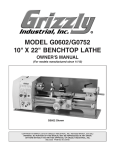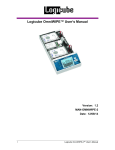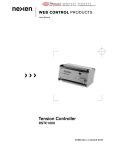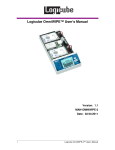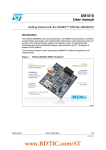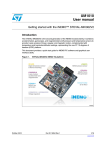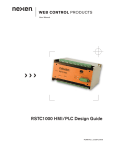Download Tension Controller
Transcript
WEB CONTROL PRODUCTS User Manual Tension Controller RSTC1000 & RSTC1100 FORM NO. L-21204-C-0908 DANGER Read this manual carefully before installation and operation. Follow Nexen’s instructions and integrate this unit into your system with care. This unit should be installed, operated and maintained by qualified personnel ONLY. Improper installation can damage your system or cause injury or death. Comply with all applicable codes. Manufacturers’ Declaration In accordance with the CE machine directive 98/37/EC, Appendix II B We hereby declare that the pneumatic/mechanical components described in this manual as well as their individual components are intended, in the configuration in which they have been supplied, to be integrated into a machine. They must not be put into service until the machinery into which it is to be incorporated has been declared in conformity with the provisions of the Directive mentioned above or its amendments. All Nexen products are designed in accordance with the manufacturing directives for pneumatic systems according to EN 983. In accordance with Nexen’s established policy of constant product improvement, the specifications contained in this manual are subject to change without notice. Technical data listed in this manual are based on the latest information available at the time of printing and are also subject to change without notice. Technical Support: 800-843-7445 (651) 484-5900 www.nexengroup.com Nexen Group, Inc. 560 Oak Grove Parkway Vadnais Heights, MN 55127 ISO 9001 Certified FORM NO. L-21204-C-0908 2 Copyright 2005 Nexen Group, Inc. Table of Contents Introduction ----------------------------------------------------------------------------------------------------------------------------------------4 Wiring Installation Guidelines --------------------------------------------------------------------------------------------------5 Installation -----------------------------------------------------------------------------------------------------------------------------6 Electrical Connections ------------------------------------------------------------------------------------------------------------7 Input/Output Descriptions -----------------------------------------------------------------------------------------------10 Setup --------------------------------------------------------------------------------------------------------------------------------- 12 RSTC to PC USB Communications ---------------------------------------------------------------------------------12 Display Window --------------------------------------------------------------------------------------------------------------12 Setup Window----------------------------------------------------------------------------------------------------------------12 Torque Actuator --------------------------------------------------------------------------------------------------------------13 Tension Zone ------------------------------------------------------------------------------------------------------------------13 Alarms ---------------------------------------------------------------------------------------------------------------------------14 Web ------------------------------------------------------------------------------------------------------------------------------14 Outputs -------------------------------------------------------------------------------------------------------------------------14 Signal Calibration -----------------------------------------------------------------------------------------------------------------15 Tension Signal Calibration------------------------------------------------------------------------------------------------15 Diameter Signal Calibration----------------------------------------------------------------------------------------------16 Run/Stop Signal Selection -----------------------------------------------------------------------------------------------16 Tuning ------------------------------------------------------------------------------------------------------------------------------- 18 RSTC Tuning Window -----------------------------------------------------------------------------------------------------18 Tuning Procedure ------------------------------------------------------------------------------------------------------------18 Setpoint -------------------------------------------------------------------------------------------------------------------------19 Advanced -----------------------------------------------------------------------------------------------------------------------19 Taper Tension -----------------------------------------------------------------------------------------------------------------19 Network Port Setup -------------------------------------------------------------------------------------------------------------20 Operation ----------------------------------------------------------------------------------------------------------------------------20 Manual Control ---------------------------------------------------------------------------------------------------------------20 Unwind Application ---------------------------------------------------------------------------------------------------------21 Splicing Unwind Application --------------------------------------------------------------------------------------------21 Wind Application ------------------------------------------------------------------------------------------------------------22 Splicing Wind Application------------------------------------------------------------------------------------------------22 Spring Disengaged Clutch -----------------------------------------------------------------------------------------------23 Mid-Process Application --------------------------------------------------------------------------------------------------23 Diagnostics --------------------------------------------------------------------------------------------------------------------23 Specifications ----------------------------------------------------------------------------------------------------------------------24 Part Numbers ----------------------------------------------------------------------------------------------------------------------24 Troubleshooting -------------------------------------------------------------------------------------------------------------------25 Service Instructions --------------------------------------------------------------------------------------------------------------26 Appendix -----------------------------------------------------------------------------------------------------------------------------26 Warranty -----------------------------------------------------------------------------------------------------------------------------27 3 FORM NO. L-21204-C-0705 INTRODUCTION Nexen RSTC Tension Controllers are used to control web tension, relying on load cell based tension sensors to measure web tension. As a part of a tension control system, the RSTC measures the web’s tension and corrects tension errors by sending a signal to change the torque output of brakes, clutches, and motor drive systems. The RSTC automatically adapts to changes in inertia and torque as roll diameters change. This ensures constant/stable tension at all times and allows for faster accelerations and decelerations for a more productive web machine. The RSTC does not require a diameter sensor for constant tension applications and can adapt to spliced rolls of different diameters automatically without readjustment. Applications for the RSTC include unwinding, mid process, constant tension winding, and taper tension winding. RSTC1000 SYSTEM The RSTC1000 Tension Control System includes three components: the RSTC1000, RSTC Operator Panel (ROP), and RSTC Communications Software. The RSTC1000 tension controller can be used as a slave on a Modbus RTU network. Because of this capability, many Human Machine Interfaces (HMIs) and Programmable Logic Controllers (PLCs) can communicate directly with it. Web machines that already have a capatible HMI control panel do not require the ROP. The Communications Software features setup, tuning and diagnostics functions and is available from the Nexen website: www.nexengroup.com. RSTC1100 SYSTEM The RSTC1100 Tension Control System includes two components: the RSTC1100 and RSTC Communications Software. The RSTC1100 tension controller can be used as a slave on a Profibus DP network. Because of this capability, many Human Machine Interfaces (HMIs) and Programmable Logic Controllers (PLCs) can communicate directly with it. The Communications Software features setup, tuning, and diagnostics functions and is available from the Nexen website: www.nexengroup.com. MOUNTING The RSTC is designed to mount inside the machine’s control cabinet alongside other controllers, PLCs, relays, etc. Small size and its DIN rail mounting capability make installation fast and easy. Pluggable connectors simplify wiring as they can be removed for convenient access to terminals. Only requiring a commonly available 24 VDC supply, the RSTC requires no hazardous voltages. Figure 1 FORM NO. L-21204-C-0908 4 WIRING INSTALLATION GUIDELINES This product is designed to minimize the effects of ElectroMagnetic Interference (EMI) on its operation, but as with any electronic device, proper installation and wiring methods are necessary to ensure proper operation. By doing so, the interference from external effects such as electrical line spikes, electrical noise, static electricity, etc. will be minimized. The following methods outline wiring installation guidelines to protect your system: • All input and output signal and sensor cables must be shielded with the shields tied to earth ground at one end. In case of very high frequency (MHz range) electrical noise, both ends of the shield need to be tied to earth ground. • Keep cable length and unshielded leads as short as possible. Think of them as antennae for noise. • Use power line filters to suppress interference on the AC voltage lines that power the unit. Relay • Place a resistor-capacitor network (snubber) across inductive coils such as relays and solenoids in order to stop electrical interference at the source (See Figure 2). • Isolate signal and sensor cables from cables carrying AC voltages, power for high current loads or relays and solenoids. Either relocate the signal and sensor cables away from other cables or use grounded metal conduits to shield them. This will reduce the potential for noise interference between the signal and sensor cables and the other noisy cables. R Snubber C Figure 2 Snubber applied across relay coil For environments that experience high levels of static electricity follow these additional guidelines: • Remove the static charge from material carrying it. In the case of webs that carry static charges, there are static charge removal products available such as static bars and ionized blowers. • Ensure that sensors and machine frames are grounded to earth through a low impedance path. • Wrap grounding tinsel around sensors and cables that are close to the source of the static electricity and ground the tinsel to earth. • Tie all signal and sensor cable shields directly to earth ground without passing through the electronic device. This will help prevent high voltage interference from coupling into other circuits within the device. 5 FORM NO. L-21204-C-0705 INSTALLATION Mount the RSTC within a user-supplied enclosure, typically the machine’s controls cabinet. The RSTC can be mounted on 35 mm DIN rail or panel mounted (Refer to Figure 3). CAUTION Mount the RSTC in a shock and vibration free area with an ambient temperature of less than 140°F [60 C] and more than 32°F [0 C]. 13.9 [0.55] 13.9 [0.55] 110.3 [4.34] 149.0 [5.87] R2.2 [0.09] 4X 134.1 [5.28] 35.0 [1.38] 75.0 [2.95] 7.4 [0.29] 1.1 2X [0.04] 7.4 [0.29] Figure 3 FORM NO. L-21204-C-0908 6 60.2 [2.37] ELECTRICAL CONNECTIONS Power Indicator RSTC Reset USB Network Port and Indicators Power Input* +24 VDC Common Earth Ground** Alarm 1 Out Alarm 2 Out Alarm Common † Alarm Shield Control Output A 0-10 VDC Output Common 4–20 mA Output Common Control Output B † Signal Shield 0–10 VDC Output Common 4–20 mA Output Common † Signal Shield 1 2 3 4 5 6 7 8 9 10 11 12 13 14 15 16 17 18 19 20 21 22 23 46 45 44 43 42 41 40 39 38 37 36 35 34 33 32 31 30 29 28 27 26 25 24 Control Signal Shield & Earth Ground** † Control Signal Common Splice B Input Splice A Input Control Inputs Run/Stop Input Signal Shield † Common Remote Tension Setpoint Input +12 VDC Excitation Common Diameter Sensor Input +24 VDC Excitation Load Cell Shield † Excitation Common +6 VDC Excitation Load –Sensor Signal Cell 2 +Sensor Signal Excitation Common +6 VDC Excitation Load –Sensor Signal Cell 1 +Sensor Signal * Power cable must be less than 10 m [390 in]. ** There are two terminals that require a low impedance connection to earth ground. † For improved signal integrity in noisy environments, tie cable shields directly to Earth Ground. Figure 4 Electrical Connections 7 FORM NO. L-21204-C-0705 User Supplied VD C* (See Specifications for maximum voltage.) RSTC R (See Note.) Alarm Out To PL C Input Alarm Common VD C Common User Supplied NOTE: The minimum value of resistor (R) is 7 x VDC. Alarm Output Tied to PLC Input. User Supplied External Indicator (See Note.) RSTC R VDC* Alarm Out (See Specifications for maximum voltage.) Alarm Common VD C Common User Supplied NOTE: The minimum value of Resistor (R) is equal to VDC divided by the maximum current limit of the Indicator. Maximum current limit of the indicator must be less than the current limit of the alarm output (See Specifications for maximum current). Alarm Output Tied to External Indicator User Supplied (See Notes.) External Coil RSTC Alarm Out VDC * 1N4002 Alarm Common (See Specifications for maximum voltage.) VD C Common User Supplied NOTE: Be sure the current requirement of the External Coil does not exceed the capability of the alarm output (See Specifications for maximum current. Any inductive load such as relay coil must have a 1N4002, or equivalent, diode across it as shown. Alarm Output Tied to External Inductive Coil * To isolate the Alarm Output signals use power supply that is separate from the RSTC power supply. FIGURE 5 Alarm Output Connections FORM NO. L-21204-C-0908 8 32 33 34 35 36 37 38 39 40 41 42 43 44 45 46 Cable Shields DC Common Run/Stop 1–5 kΩ Potentiometer +12 to + 24 VDC Splice B NOTE: To isolate the Control Input Signals, use a power supply that is separate from the RSTC power supply. NOTE: Potentiometer can be replaced with analog voltage signal by connecting analog signal (0-12V maximum) to terminal 37 and signal common to terminal 38. Figure 6 Figure 7 Splice A Control Input Signals 24 25 26 27 28 29 30 31 32 33 34 24 25 26 27 28 29 30 31 32 33 34 G W R B G W R B No. 1 Sensor G W R B No. 2 Sensor Single MB 24 25 26 27 28 29 30 31 32 33 34 R B W B R +Vex –Vex Vsig +Vex –Vex Sensor 1 24 25 26 27 28 29 30 31 32 33 34 Cable Shield Add Jumpers W Add G W R B SW Sensor Colors +Vsig –Vsig +Vex –Vex Sensor 2 Cable Shield CFL Sensor Colors Sensor SW or Half Bridge Strain Guage Load Cell Figure 8 Add Cable Shield Sensor Dual MB Vsig Remote Tension Setpoint CFL or Single Full Bridge Strain Gauge Load Cell Load Cell Connections 9 FORM NO. L-21204-C-0705 Shield is the terminal for connecting the alarm cable shield to chassis ground. INPUT/OUTPUT DESCRIPTIONS NOTE: Refer to Figure 4 for RSTC Pinout. Control Outputs: The Control Output signal is used to change the torque output of a pneumatic brake or clutch via an electro-pneumatic converter or a motor drive system for the purpose of controlling tension. There are two channels of control outputs, Control Output A and Control Output B. Each channel has a 0 – 10 VDC and 4 – 20 mA output signal. All Control Outputs are isolated from the RSTC power supply. Only one channel at a time can be used to control tension. When one channel is active the other channel is in standby mode. The choice of whether a Control Output is active or in standby mode is made with the Splice Control Inputs. The 0 – 10 VDC and 4 – 20 mA terminals are the control signal outputs. Common is the return line for the control signal outputs. Signal Shield is the terminal for connecting the cable shield to chassis ground. USB Port: This port is used to connect to a personal computer during setup, tuning, or diagnostic monitoring of the RSTC and is compliant with USB 2.0. Network Port: This port is for communicating with the RSTC using a networking protocol. Refer to the HMI/PLC Design Guide for network specific information. Network Indicators: Indicators will illuminate to show status of network communications. Refer to the HMI/PLC Design Guide for network information. Power Input: RSTC requires 24 VDC to operate (Refer to SPECIFICATIONS for current rating). A green indicator visible through the top cover will illuminate when this voltage is present. Common is the return line for the 24 VDC power supply. Earth Ground is the terminal for connection to Earth Ground via a low resistance conductor. Two terminals, 3 and 46, must be connected to Earth Ground in order for cable shielding to work properly. Load Cell Inputs: The RSTC will accommodate two web tension sensing load cells. Polarity of the load cell signals does not matter as long as the polarity of both load cell input signals are oriented the same. The +/- Sensor Signal is for the tension level signal from the load cells. The +6 VDC Excitation is the power supply for the load cells. Excitation common is the return line for the load cell power. Load cell cable shields must be tied directly to Earth Ground for best noise reduction Reset: A reset switch, accessible through the top cover, will reset the RSTC whenever depressed without having to cycle power on and off. Alarms: Transistor outputs that can be configured for normally open or normally closed operation (Refer to SPECIFICATIONS for ratings). Alarm 1 is activated whenever a web break is detected. Alarm 2 is activated whenever one or more of the following conditions occur: Diameter Input: This input provides winder roll diameter measurements for the taper tension algorithm and is not used for anything else. Diameter signal can be provided by a diameter sensor or voltage source, such as a PLC’s analog output card, capable of 0 – 12 VDC maximum signal range. The +24 VDC Excitation and +12 VDC Excitation provide power when using a diameter sensor. Common is the return line for the diameter signal and sensor excitation. Diameter Sensor Shield is the terminal for connecting the diameter sensor cable shield to chassis ground. No Control: control signal output has reached 0% or 100% during automatic operation and web tension is not at set point. This is often caused by accelerating a large roll too quickly or excessive web speed near core. Both cases can cause excessive tension with a control output at 0% and unable to decrease any further. “No control” can also be cause by a large roll decelerated too quickly causing the output to go to 100%, but the web tension remains below setpoint. Remote Tension Setpoint: This 0 - 12 VDC input allows the tension setpoint to be set by an external potentiometer or analog signal (See Figure 7). Remote Tension Setpoint is scaled such that 0 V corresponds to Minimum Tension Setpoint and 12 V corresponds to Maximum Tension Setpoint. When using a PLC that outputs lower than 12 V, adjust the Maximum Tension Setpoint to compensate. Before using Remote Tension Setpoint, it must be enabled, see TUNING, afterwards tension setpoint changes from all other sources are ignored. High Tension: Web tension is greater than the hightension limit. Low Tension: Web tension less than low-tension limit. Max Output: Control signal output has reached maximum output limit, typically 100%. Web Tension Monitor: Web tension can be monitored as a 0 – 10 VDC or 4 – 20 mA signal from Control Output B when enabled, see SETUP. Web Tension Monitor is Zero Output: Control signal output has reached minimum output limit, typically 0%. The alarm outputs can be isolated from the RSTC power supply by using a separate power source and common. Alarm Common is the return line for the alarm signal. Alarm FORM NO. L-21204-C-0908 10 INPUT/OUTPUT DESCRIPTIONS (CONT.) scaled such that 0 V or 4 mA corresponds to Minimum Tension Setpoint and 10 V or 20 mA corresponds to Maximum Tension Setpoint. If Control Output B is being used as a web tension monitoring output, then it is not available for use as a web tension control output. Only Control Output A can be used for tension control in this instance. CONTROL INPUTS Run/Stop: When 12 – 24 VDC is applied to this digital input for at least 100 milliseconds, the RSTC will respond according to Run/Stop option selected during setup of the RSTC (refer to SIGNAL CALIBRATION) and cause the RSTC to go into the run mode or the stop mode. The RSTC will actively control tension in both the run and stop modes, however the RSTC will only adapt its control gains in the run mode. During stop mode, all control gains are held constant. NOTE: For unwinding applications, do not provide the Run signal when the web remains stopped. This will cause the RSTC to increase its gains too much and produce tension oscillations when the web does finally move. Splice A/B: When 12 – 24 VDC is applied to one of these digital inputs for at least 100 milliseconds, the RSTC will respond by resetting Adaptation to a level determined by SPLICE ADAPTATION. The RSTC will also make the corresponding Control Output active and the other standby. The 12 – 24 VDC signal can be momentary or maintained, however only one Splice Input can have the signal applied at a time. After power up, the RSTC will look at the Splice A and Splice B inputs. If both are high or both are low then Control Output A is made active and Control Output B goes to standby. Therefore, apply the splice signal after power up to insure the proper Control Output is active. Any output in standby mode will maintain a constant output level as determined by STANDBY OUTPUT variable. Also, if Web Tension Output is enabled, then Control Output B is no longer available for web tension control and Splice B input is ignored. The Control Inputs can be isolated from the RSTC power supply by using a separate power source and common. Control Signal Common is the return line for the Run/ Stop and Splice A/B input signals. Control Signal Shield is the terminal for connecting the cable shield to chassis ground. 11 FORM NO. L-21204-C-0705 SETUP RSTC TO PERSONAL COMPUTER USB COMMUNICATION Power Indicator RSTC Reset In order to setup the RSTC, a USB cable and the RSTC Communications Software are required. A Type A to mini Type B 2.0 USB cable is provided with the RSTC. RSTC Communications Software is available by download from Nexen’s website, www.nexengroup.com. Enter RSTC product number (See PART NUMBER section) in the product number search window and press Go; next select Software from the Accessories menu and finally pick the appropriate software link. Instructions for installing the software can also be found here and the instructions for using the RSTC Communications Software can be accessed in the Help menu. Network Port and Indicators Figure 9 1. Connect 24 VDC power supply to Power Input terminals (Refer to Figure 4). 2. Power up the computer. Figure 10 Display Window Figure 11 Setup Screen 3. Connect the USB cable between computer and RSTC (Refer to Figure 9). 4. Turn on 24 VDC power supply, Power indicator will be on (Refer to Figure 9). Note: Refer to the RSTC Communications Software Help menu for instructions on navigating the program and accessing its functions. The steps below describe using the functions to configure the RSTC. DISPLAY WINDOW Select the DISPLAY icon from the toolbar (See Figure 10). Units: Select IMPERIAL if tension and diameter are to be displayed in units of pounds and inches; Select METRIC if tension and diameter are to be displayed in units of newtons and millimeters. ROP Language: Select the language from the drop-down menu that the ROP will display. Press SEND to update the RSTC. SETUP WINDOW Select the SETUP icon from the toolbar (See Figure 11). Note: After changing values, the SEND key must be pressed to send the values to the RSTC. FORM NO. L-21204-C-0908 12 USB TORQUE ACTUATOR Actuator: Select from the Torque Actuator drop down menu the type of actuator the RSTC will control. Actuator Inertia: Enter the rotor inertia of the brake or clutch in the designated imperial or metric units. The choice of units is determined by selecting the DISPLAY icon and then selecting Imperial or Metric in the UNITS pane. Inertia values for Nexen Brakes and Clutches can be found in the Nexen catalog or website. For drive systems, enter the motor rotor, drive pulley, and shaft coupling inertias. Refer to Appendix for inertia formulas and table of values. Use an Actuator Inertia value of 1.0 in cases where the actual value is not known. Figure 12 Torque Actuator Selection Screen RSTC Controlled Nip TENSION ZONE Select whether the RSTC will control a winder or unwind tension zone. For mid-process applications select Wind if the controlled nip is downstream of the leader nip and select Unwind if the controlled nip is upstream of the leader nip (Refer to Figure 13). Leader Nip Select Unwind Load Cell Leader Nip RSTC Controlled Nip Select Wind Load Cell Tension Zone Selection for Mid-Process Application Figure 13 13 FORM NO. L-21204-C-0705 ALARMS NOTE: A web break is detected whenever the web tension falls below 10% of the Maximum Tension Setpoint Alarm 1 is used to signal the break. Tension Tolerance: Enter the tolerance (0–100 %) of the tension setpoint to establish the limits for the High Tension and Low Tension alarms. For example, if Tension Tolerance is set to 10 and the Tension Setpoint was 100, then the High Tension alarm would be activated if the web tension exceeded 110 and the Low Tension alarm would be activated if the web tension fell below 90. These alarms utilize Alarm 2 to signal their condition. Alarm Outputs: Select if the alarm outputs are to be normally open (NO) or normally closed (NC). A normally open output will close during an alarm condition while a normally closed output will open. Figure 14 WEB Max Diameter: Enter in the maximum full roll diameter that will be used. For mid-process tension control applications, enter 1.1 multiplied by the nip roller diameter. Min Core Diameter: Enter in the minimum core diameter that will be used. For mid-process tension control applications, enter the diameter of the nip roller. Avg Web Width: Enter in the average web width [(maximum width + minimum width) / 2]. Material: Select the web material to be used: Paper or Plastic, Steel, or Aluminum from the drop down menu (See Figure 14). OUTPUTS Minimum Output %: Used to specify a minimum output level, typically set to 0 %. Minimum Output is often set to a value greater than zero in order to overcome the spring force in brakes and clutches that are spring disengaged. Maximum Output %: Used to specify the maximum output level, typically set to 100%. Standby Output %: Used to specify the output level in standby mode (not controlling tension). Standby Output is often used in splicing unwind applications when it is desired to have some brake drag on the make ready roll. Tension Monitor: Select ON and Control Output B will output web tension monitor signal or select OFF and control Output B will output web tension control signal (See Web Tension Monitor in INPUT/OUTPUT DESCRIPTIONS section). FORM NO. L-21204-C-0908 14 Web Material Selection Screen SIGNAL CALIBRATION SIGNAL CALIBRATION WINDOW Select the SIGNAL CALIBRATION icon from the toolbar. (See Figure 15). TENSION SIGNAL CALIBRATION Set the Maximum Tension Setpoint before calibrating tension sensors. Afterwards, re-calibration of tension sensors is required whenever the Maximum Tension Setpoint is changed. Minimum Tension Setpoint: Enter minimum tension level that will be run on the machine in the designated imperial or metric units. The choice of units is determined by selecting the DISPLAY icon and then selecting Imperial or Metric in the UNITS pane. Figure 15 Signal Calibration Figure 16 Tension Calibration Maximum Tension Setpoint: Enter maximum tension level that will be run on the machine in the designated imperial or metric units. The choice of units is determined by selecting the DISPLAY icon and then selecting Imperial or Metric in the UNITS pane. NOTE: Selection of tension setpoints outside these limits will not be allowed by the RSTC and the Minimum Tension Setpoint will limit taper tension’s minimum tension. Calibration Set: Select Set 1, Set 2 or Set 3 The RSTC allows the use of three different sets of calibration values for converting load cell output voltages into tension values. These calibration sets can be used for different web paths that utilize the same set of load cells and have different web wrap angles. 1. Press TENSION (See Figure 16). 2. Under Calibration Set 1, enter the web tension that will be used to calibrate the span condition into the SPAN TENSION box . Span Tension is equal to the weight as shown in Figure 17 and should be set as close as practical to MAXIMUM SETPOINT. 3. Press CALIBRATE 1. 4. Unload the tension sensing roller and then press OK. The tare condition, which is the weight of the roller, has just been recorded. Figure 17 For other web paths using the same load cells, repeat steps 1–6 for Calibration Set 2 and Set 3. 5. Load the tension sensing roller, as shown in Figure 17, using the amount of web tension entered for SPAN TENSION in step 2 and then press OK. 7. 6. Unload the tension sensing roller and then press OK. The tare condition is rechecked and the calibration process is completed. 15 To select a calibration set to be used, select Calibration Set 1, Set 2, or Set 3 and press SEND. FORM NO. L-21204-C-0705 DIAMETER SIGNAL CALIBRATION 1. Press DIAMETER (See Figure 18). 2. Press Yes if a diameter signal is present and continue with calibration. Press No if there is not a diameter signal, therefore the calibration procedure will not continue. 3. Enter the core diameter and large roll diameter that will be used for calibration. Core and large roll diameters can be any representative diameter, not the minimum and maximum diameters used on the machine. Figure 18 Diameter Calibration Figure 19 Run/Stop Signal Selection Screen 4. Press CALIBRATE and apply the voltage that represents the core diameter to the Diameter Input. 5. Press OK and apply the voltage that represents the large roll diameter to the Diameter Input. 4. Press OK and the calibration is completed. It does not matter if the diameter signal voltage increases or decreases with increasing diameter. RUN/STOP SIGNAL SELECTION Note: After making a selection, the SEND key must be pressed to send the values to the RSTC. The RSTC determines the run and stop state of a web machine through the Run/Stop signal input and was designed to accommodate many different types of run and stop machine state signals. The following figure and descriptions detail the variations of Run/Stop signals that the RSTC accepts. RUN/STOP SIGNAL MAINTAINED When the Run/Stop input signal is maintained low, the RSTC assumes the machine is stopped. When the Run/ Stop input signal transitions to a maintained high, the RSTC algorithm will begin adapting to account for the roll’s diameter and inertia. The web must be in motion for unwinding applications or in tension for winding applications when this signal goes high otherwise the Adaptive Gain will increase to maximum. After the Run/ Stop signal transitions back to low, the Adaptive Gain will return to Initial Adaptation (See OPERATION section). CONTINUED FORM NO. L-21204-C-0908 16 RUN ONLY SIGNAL MOMENTARY RUN PULSED (ENCODER) When the Start/Stop input signal pulses high, the RSTC algorithm will begin adapting to account for the roll’s diameter and inertia. The web must be in motion for unwinding applications or in tension for winding applications when this signal goes high otherwise the Adaptive Gain will increase to maximum. After the machine stops, the RSTC will continue trying to adapt until the Run/Stop input pulses high again and forces the adaptation process to start over from Initial Adaptation. The first time a machine driven encoder pulses Run/Stop input, the RSTC algorithm will begin adapting to account for the roll’s diameter and inertia. The web must be in motion for unwinding applications or in tension for winding applications when this signal goes high otherwise the Adaptive Gain will increase to maximum. The RSTC will continue to actively adapt until the encoder pulsing ceases for three seconds. At that time, the RSTC assumes the machine has stopped and the Adaptive Gain will return to Initial Adaptation (See OPERATION section). The encoder pulse frequency must be in the range of 1Hz to 10 kHz. RUN/STOP SIGNAL MOMENTARY When the Run/Stop input signal pulses high, the RSTC algorithm will begin adapting to account for the roll’s diameter and inertia. The web must be in motion for unwinding applications or in tension for winding applications when this signal goes high otherwise the Adaptive Gain will increase to maximum. After the Run/Stop signal pulses high a second time, the Adaptive Gain will return to Initial Adaptation, as the RSTC assumes the machine has stopped (See OPERATIONS section). RUN/STOP VIA COMMUNICATIONS Select this option if the Run/Stop signal will be provided by software command over an industrial network. After determining the appropriate signal type, make a selection from the list of options in the Run/Stop Window (refer to Figure 19) and press SEND. 100% Machine Speed 0% Time Run / Stop (Maintained) Run / Stop (Momentary) -t- Pulse Time (t) must be > 100ms Run Only (Momentary) Run Pulsed (Encoder) Figure 20 17 FORM NO. L-21204-C-0705 TUNING TUNING WINDOW Select the TUNING icon from the toolbar. (See Figure 21). Note: After changing values, the SEND key must be pressed to send the values to the RSTC. Gain: Adjusts response of RSTC to magnitude changes in tension. Higher values cause a more aggressive response and lower values cause a lesser response. Stabilization: Tunes the tension control algorithm to the natural frequency of the empty core shaft that is being controlled. When set properly this parameter allows the gain to be set for best performance. TUNING PROCEDURE Figure 21 Most applications will only require adjustment of Gain and Stabilization to tune the RSTC. Advanced tuning parameters are available for more demanding applications. Tuning Screen 3. Start the machine and run at a moderate web speed and tension. Note if the output oscillates excessively or if the amount of time taken to reach the tension setpoint after web speed becomes consistent is too long. It is normal for the output value to fluctuate as long as the web tension does not. Note: To view diagnostics while tuning, select the DIAGNOSTICS icon from the toolbar; then select START in the Communication Pane (See Diagnostics Section). The RSTC features an adaptive algorithm that is user tuned. After tuning, the algorithm will automatically adapt internal gain values to account for changes in roll diameter and inertia. This algorithm is modeled after unwinding and winding applications which results in an non-linear adaptation process that closely follows the actual changes occurring in a web machine. Stabilization is an important variable that must be set properly for the RSTC to perform correctly. If it is set too low, Gain will not be able to be set high enough for proper operation and could also cause a high frequency tension oscillation. If it is set too high, the RSTC could produce a low frequency tension oscillation. • If the output oscillations are not excessive and the amount of time is too long, stop the machine. Increase Gain by 0.5 and return to step 3. • If the output signal begins to oscillate excessively, stop the machine. Decrease Gain by 0.5 and return to step 3. • If performance is satisfactory, proceed to step 4. 4. Load a small roll on to the roll stand. 5. Start the machine and note if there are excessive output oscillations. When tuning it is important to check for output oscillations during large and small roll machine start conditions. Further, initial tuning performed for a small roll may not result in adequate performance with a full roll as the RSTC could be sluggish. Therefore, start with Gain and Stability set at their default values and begin tuning with as large a roll as practical. For winding applications, us the default Stabilization and Gain value and only change the Gain as necessary in order to build a large roll then follow the tuning procedure. • If the output oscillations are excessive, stop the machine. Reduce the Gain by 0.5 and return to step 5. 6. Continue to test for output oscillations until the roll is as small as practical. During tuning, if the Gain value reaches 1.0 and further adjustment is required, then stop the machine, decrease Stabilization by 1.0, set Gain to 2.5 and return to the tuning process. 1. Set Stabilization to 15.0 and Gain to 2.5 Likewise during tuning, if the Gain values reaches 10.0 and further adjustment is required, then stop the machine, increase Stabilization by 1.0, set Gain to 2.5, and return to the tuning process. 2. Load as large a roll as practical on to the roll stand. 18 FORM NO. L-21204-C-0705 SETPOINT Remote SP: Select ON to enable tension setpoint by external analog signal (See I N PUT/OUTPUT DESCRIPTIONS section) or OFF to disable this feature. When enabled, tension setpoint changes from all other sources are ignored. Tension Setpoint: Enter the desired web tension level. The Tension Setpoint range is set by the Maximum and Minimum Tension Setpoint values in the Setup window. ADVANCED process is started closer to its final value in order to arrive at the desired gains quicker. It is important to not set Splice Adaptation so high that when a smaller than average roll is spliced the tension begins to oscillate. Best recommendation is to use the default value and only change if absolutely necessary. For winding applications, this value is set equal to Initial Adaptation. Initial Adaptation: is the beginning point for the adaptation process after the RSTC enters Run mode. Tension oscillations could occur during a machine start when roll size is near core diameter if this value is set too high. Tension could be slow to come up to setpoint after a machine start if this value is set too low. Best recommendation is to use the default value and only change if absolutely necessary. Adaptation Rate: effects how fast the RSTC adapts to a roll’s diameter and inertia. If set too low, the time taken to adapt will be long and the tension would be slow to come up to the setpoint. If set too high, the time taken to adapt will be short and a high frequency tension oscillation could result. Best recommendation is to use the default value and only change if absolutely necessary. Splice Adaptation: is the beginning point for the adaptation process after the RSTC receives a Splice signal. For unwinding applications, this value is typically set higher than Initial Adaptation and gives the adaptation process a jump-start as the splice process usually involves larger rather than smaller rolls. The idea is that the adaptation TAPER TENSION #ONSTANT 4ENSION 4ENSION 3ETPOINT During winding applications, it is often necessary to reduce the tension setpoint as the roll increases in diameter in order to prevent excessive internal roll stresses from causing roll defects such as starring, telescoping, and crushed cores. Decreasing the tension setpoint is handled automatically when a roll diameter sensor or signal is used to provide the winding roll diameter to the RSTC. 4ENSION 3MALL4APER 6ALUE ,ARGE4APER 6ALUE Taper: Taper determines the amount that the tension setpoint is reduced, in a linear fashion, as the winding roll diameter increases. Larger values will increase the rate of tension setpoint decrease while smaller values will reduce the rate of tension setpoint decrease (Refer to Figures 22 and 23). The tapering of the web tension will continue until the roll is finished or Minimum Tension Setpoint is reached. -INIMUM 4ENSION 3ETPOINT #ORE &ULL 2OLL$IAMETER Figure 22 Taper Delay: Taper Delay will prevent a decrease in tension setpoint from happening until the roll reaches this diameter. Taper Tension #ONSTANT 4ENSION 4ENSION 3ETPOINT 4ENSION Taper Enable: Select ON to enable web tension tapering or OFF to disable this feature. 4APER 4ENSION Use the following formula to calculate Taper for Roll Diameter > Delay: Taper = Desired Tension Change * Unit Beginning Tension Setpoint * (roll dia. - delay) #ORE $ELAY &ULL 2OLL$IAMETER Unit = 1000 for imperial units [lb & in] 25400 for metric units [N and mm] FORM NO. L-21204-C-0908 Figure 23 19 Taper Tension with Delay NETWORK PORT SETUP MODBUS PORT SETUP Select the Network Communications Setup icon from the toolbar. Use this window to select parameters needed to establish Modbus RTU communications with a master device. Baud Rate: Use the pull down selection box to specify the communication speed required by the Modbus master device. If connecting to Nexen’s RSTC Operator Panel, select 19200. Parity: Use the pull down selection box to specify the type of parity required by the Modbus master device. If connecting to Nexen’s RSTC Operator Panel, select None. Stop Bits: Use the pull down selection box to specify the number of stop bits required by the Modbus master device. If connecting to Nexen’s RSTC Operator Panel, select 2. RSTC Device Address: Specify the device address required by the Modbus master device. If connecting to Nexen’s RSTC Operator Panel, select 24. Figure 24 MODBUS Port Setup Screen Figure 25 PROFIBUS Port Setup Screen Figure 26 Manual Control Window Port Settings: select to update the settings immediately or the next time the RSTC is powered on. PROFIBUS PORT SETUP Select the Network Communications Setup icon from the toolbar. Use this window to select parameters needed to establish Profibus communications with a master device. RSTC Device Address: Specifies the device address required by the Profibus master. OPERATION MANUAL CONTROL Manual control of the RSTC’s control output is useful for troubleshooting. The AUTOMATIC/MANUAL button of the OPERATION MODES pane in the DIAGNOSTICS window indicates the current control mode (see Figure 29). Pressing AUTOMATIC will switch control to MANUAL mode and change the button display to MANUAL, indicating the new control mode. A window will appear allowing you to manually adjust output levels (See Figure 26). The INCREASE and DECREASE buttons increase or decrease the control output level to the brake, clutch, or drive in 1% or 10% increments. Press SWITCH TO AUTOMATIC CONTROL to return to automatic control mode. FORM NO. L-21204-C-0908 20 UNWIND APPLICATION As the roll begins to accelerate, the web tension will settle on a level determined by TENSION SETPOINT. Next, as the roll decreases in size, so will the Adaptation and Output values. It is normal for the RSTC’s output value to fluctuate slightly as long as the web tension does not. A typical unwind application begins with a new full roll. To insure that the web tension reaches setpoint as quickly as possible, the Splice signal can be used to reset Adaptation to a higher level, set by SPLICE ADAPTATION, before the machine starts. This shortens the time it takes for the RSTC1000 to adapt its gains to the new roll. During a machine stop, Adaptation and Output values will initially increase to overcome a roll’s inertia. After a Stop signal is given, when the web has come to a stop, the Adaptation value will reset to INITIAL ADAPTATION. If a Splice signal is not used, the web tension may take a little longer to reach setpoint after the RSTC goes into the Run mode. As long as this does not present a problem, then the Splice signal can be ignored. When the RSTC is in Stop mode, the Adaptation value will remain constant and the Output value will change depending on the web tension. The MAXIMUM OUTPUT value is used to limit how high the output can rise. Likewise, MINIMUM OUTPUT value is used to limit how low the output can drop. This is useful for applications where a minimal amount of output is necessary to over come the spring force in a spring-disengaged brake. When the Run signal goes high at the Run/Stop input, the RSTC will begin adapting from INITIAL ADAPTATION. Adaptation is displayed graphically in the DIAGNOSTICS window, however Adaptation and INITIAL ADAPTATION values will not match, because INITIAL ADAPTATION is one of several variables used to calculate Adaptation. NOTE: The web must begin to move when the Run signal is given. SPLICING UNWIND APPLICATION The RSTC utilizes “Smart Splicing,“ meaning that rolls of different sizes can be loaded or spliced into the machine without readjusting the controller. The RSTC will adapt automatically to the new roll after receiving the splice signal. When the splice input pulses high, the controller will reset adaptation to the level defined by Splice Adaptation. This shortens the time it takes for the RSTC to adapt its gains to the new roll. The splice input can be used anytime a new roll is loaded on the machine, with the machine running or stopped. The splice input must be held high for at least 100 ms for the RSTC to detect this signal. The adaptation process will begin immediately if the machine is running or will begin after the RSTC receives a Run signal. NOTE: If the new roll is smaller than the one used to set up Splice Adaptation, the adaptation level could start out too high after a splice, and the tension may become unstable until the gains have adapted down. At the time of the splice, the RSTC must receive a Splice A or Splice B signal. This will cause the corresponding control output to become the active output controlling web tension. If the new roll is to be controlled by Output B, then the splice signal is given to the Splice B input. After the splice signal is received, the opposite control output goes into standby mode, causing the output to remain at a constant level as specified by STANDBY OUTPUT. Large Roll Small Roll Optimum Gain Reached Adaptation Splicing Adaptation Initial Adaptation Run Speed Acceleration Run Speed Acceleration Deceleration Deceleration Stopped Splice Signal Run/Stop Signal Figure 27 21 FORM NO. L-21204-C-0705 WIND APPLICATION During a machine stop, Adaptation and Output values will initially increase to overcome a roll’s inertia. It is normal for the RSTC to remain in Run mode throughout the deceleration and while the web is at zero speed as long as the web tension is capable of being controlled. Otherwise, the RSTC must go into Stop mode after the web has stopped moving. A typical winding application begins at core. The INITIAL ADAPTATION value should be set high enough to allow the tension setpoint to be reached quickly after the Run signal is given. Many winders are started before the machine begins to move the web. This is not a problem as the winder is active, even at zero web speed, and the RSTC can control tension while in Run mode without the adaptation process adjusting the gains too high. Tapering of the winding tension is possible with the addition of a diameter sensor or signal that can provide a diameter reference for the RSTC. Refer to Taper Tension in the TUNING section for more information. As the roll begins to accelerate, the web tension will settle on a level determined by Tension Setpoint. Next, the roll will continue to increase in size along with the Adaptation and Output values. It is normal for the RSTC’s output value to fluctuate as long as web tension does not. SPLICING WIND APPLICATION At the time of the splice, the RSTC must receive a Splice A or Splice B signal. This will cause the corresponding control output to become the active output that controls the web tension. If the new roll is to be controlled by Output B, then the splice signal is given to the Splice B input. After the splice signal is received, the opposite control output goes into standby mode which causes the output to remain at a constant level as specified by Standby Output. The RSTC utilizes “Smart Splicing” when transitioning to a new roll on a web. This means that rolls of different sizes can be loaded or spliced into the machine without having to readjust the controller. The RSTC will adapt automatically to the new roll after receiving the splice signal. When the splice input pulses high, the controller will reset the adaptation to the level defined by Splice Adaptation. The splice input can be used anytime a new roll is loaded on the machine and the machine can be running or stopped. The splice input must be held high for at least 100 ms for the RSTC to detect this signal. The adaptation process will begin immediately if the machine is running or will begin after the RSTC receives a Run signal. Typically the SPLICE ADAPTATION value is set to the same value as INITIAL ADAPTATION for winding applications. Small Roll Large Roll Adaptation Initial Adaptation & Splicing Adaptation Web Speed Run Speed Acceleration Run Speed Acceleration Deceleration Stopped Splice Signal Run/Stop Signal Figure 28 FORM NO. L-21204-C-0908 22 Deceleration SPRING DISENGAGED CLUTCH MID-PROCESS APPLICATION It is common to use a spring-disengaged clutch on a winder and this spring can affect performance if the RSTC’s output becomes too low and the clutch begins to disengage. Use the MINIMUM OUTPUT setting to keep the control output high enough to overcome the spring force in a spring-disengaged clutch. Nexen’s RSTC is capable of mid-process tension control by adjusting the torque output of a motor or brake. Midprocess applications are similar to an unwind process when controlling from the upstream end of a tension zone, and a rewind process when controlling from the downstream end of a tension zone (Refer to Figure 13). The most notable difference is that mid-process applications deal with constant diameters and inertias. Similar to an unwind or wind application, the output level of the RSTC’s controlled outputs will increase when more tension is desired and decrease when less tension is desired. DIAGNOSTICS Select DIAGNOSTICS icon from the toolbar; then press START to begin receiving data from the RSTC. The Diagnostics window displays real-time operating information from the RSTC. This can be used throughout the setup procedure to verify results from sensors and setup parameter settings. All functions of the Diagnostics window are explained in the HELP files of the RSTC Communications software. Figure 29 Diagnostics Screen 23 FORM NO. L-21204-C-0705 SPECIFICATIONS POWER Input TEMPERATURE Operating Temperature DIGITAL SIGNALS Alarm Outputs Control Inputs ANALOG SIGNALS Diameter Sensor Input Remote Tension Setpoint Input Load Cell Inputs Control Output 1 Control Output 2 SENSOR EXCITATIONS Load Cell Excitation Other Sensor Excitations CERTIFICATIONS Certification 24 VDC at 600 mA 0-60 C [32˚ - 140˚ F] 5-24 VDC, 140 mA max, current sinking 12-24 VDC, 20 mA max 0-12 VDC 0-12 VDC 2 channels, 0-1 VDC 0-10 VDC and 4-20 mA 0-10 VDC and 4-20 mA 6 VDC 24 VDC @ 100 mA max & 12 VDC @ 60 mA CE PART NUMBERS RSTC1000 RSTC1100 (Modbus RTU Network) (Profibus DPV1 Network) FORM NO. L-21204-C-0908 964523 964528 24 TROUBLESHOOTING Problem Probable Cause Diagnosis Test Corrective Action Power Indicator is not illuminated. No power Check for 24 VDC across terminals 1 and 2 using a voltmeter. Restore 24 VDC. Improper or missing signal Measure the voltage at inputs 41, 43 and 44. Correct any problems with voltage or wiring using the SPECIFICATIONS section to determine proper range. Run signal not provided to control input or software command not given Start machine and watch for Run/Stop to go high on Diagnostics window. Check Run/Stop input wiring or control panel to make sure the command is sent properly. Run/Stop signal not set up properly Check Run/Stop configuration in Signal Calibration window. Refer to Signal Calibration section of manual and select proper configuration. RSTC in manual mode Check Automatic/Manual button on Diagnostics window. Switch to Automatic using Automatic/Manual button or issue Automatic command from control panel. Improper settings or calibration Tension not fluctuating in manual mode indicates a problem with RSTC. Web machine problem Fluctuating tension in manual mode indicates a machine problem. Correct problem with web machine. Machine acceleration rate too high Decrease acceleration rate and see if output % increases above 0%. Decrease machine acceleration as roll inertia limits acceleration rate of machine. Output goes to 0% and Acceleration of the unwinding tension rises above roll shaft causing tension setpoint when roll unwinds increase at constant web speed. Decrease web speed as roll diameter approaches core to see if output increases above 0. Decrease web speed as roll diameter approaches core because roll and shaft inertia cause tension to increase above setpoint. Output goes to 100% during deceleration and tension falls below setpoint. Machine deceleration rate is too high and there is not enough torque. Decrease deceleration rate and see if output stays below 100%. Decrease machine deceleration as roll inertia limits deceleration rate of machine or increase torque output of torque actuator. Output goes to 100% and tension falls below setpoint when roll winds at constant web speed. Decrease the tension setpoint Not enough torque for the size (increase taper) and see if of roll and the tension setpoint output stays below 100%. Control inputs do not respond. RSTC will not go into Auto mode. Tension fluctuates in automatic mode. Output goes to 0% during unwinding roll acceleration. 25 Re-tune RSTC. Recalibrate load cells. Increase torque output of torque actuator or decrease tension setpoint or increase taper. FORM NO. L-21204-C-0705 SERVICE INSTRUCTIONS Nexen does not recommend customer servicing of this product. Contact Nexen for replacement parts or repair. APPENDIX To determine WK2 of a normal shaft or disc, multiply the WK2 from the chart by the length of the shaft or thickness of the disc in inches. The value of WK2 is important for applications involving timed, cyclic duty or when starting or stopping heavy loads. Use one or all of the three methods shown here to estimate the inertia. Note: For hollow shafts, subtract WK2 of the i.d. from WK2 of the o.d. and multiply by the length. 1. The inertia of solid steel shafting is given in the following table. The values given are per inch of shaft length. 2. For solid cylinders of a given weight, WK2 is estimated by: 2 WK2 = W ( R ) 2 2 2 2 Dia (in.) WK 2 (lb ft ) Dia (in.) WK 2 (lb ft ) Dia (in.) WK 2 (lb ft ) 0.750 1.000 1.250 1.500 1.750 2.000 2.250 2.500 2.750 3.000 3.500 3.750 4.000 4.250 4.500 5.000 5.500 6.000 6.250 6.500 6.750 7.000 7.250 0.00006 0.0002 0.0005 0.0010 0.0020 0.0030 0.0050 0.0080 0.0110 0.0160 0.0290 0.0380 0.0490 0.0630 0.0790 0.1200 0.1770 0.2500 0.2960 0.3450 0.4020 0.4640 0.5350 7.500 7.750 8.000 8.250 8.500 8.750 9.000 9.250 9.500 9.750 10.000 10.250 10.500 10.750 11.000 11.250 11.500 11.750 12.000 12.250 12.500 12.750 13.000 0.6110 0.6990 0.7910 0.8950 1.0000 1.1300 1.2700 1.4100 1.5500 1.7500 1.9300 2.1300 2.3500 2.5800 2.8300 3.0900 3.3800 3.6800 4.0000 4.3500 4.7200 5.1100 5.5800 13.250 13.500 13.750 14.000 14.250 14.500 14.750 15.000 16.000 17.000 18.000 19.000 20.000 21.000 22.000 23.000 24.000 25.000 26.000 27.000 28.000 29.000 30.000 5.9600 6.4200 6.9100 7.4200 7.9700 8.5400 9.1500 9.7500 12.6100 16.0700 20.2100 25.0800 30.7900 37.4300 45.0900 53.8700 63.8600 75.1900 87.9600 102.3000 118.3100 136.1400 155.9200 Where: WK2 = intertia in lb ft2 R = cylinder radius in feet W = weight in pounds 3. For solid or hollow cylinders, the inertia is calculated by the following equations: Solid Cylinder: WK2 = .000681 p LD4 D14) Hollow Cylinder: WK2 = .000681 p L (D24 - D L Where WK2 = lb ft2 D, D1, D2, and L are in inches p = lb/in3 where p (aluminum) = .0924 p (cast iron) = .260 p (steel) = .282 Calculate the inertia of complex, concentric, rotating parts by breaking the part into simple cylinders, calculating the inertia or each, and summing the values. FORM NO. L-21204-C-0908 26 WARRANTY Warranties Nexen warrants that the Products will be free from any defects in material or workmanship for a period of 12 months from the date of shipment. NEXEN MAKES NO OTHER WARRANTY, EXPRESS OR IMPLIED, AND ALL IMPLIED WARRANTIES, INCLUDING WITHOUT LIMITATION, IMPLIED WARRANTIES OF MERCHANTABILITY AND FITNESS FOR A PARTICULAR PURPOSE ARE HEREBY DISCLAIMED. This warranty applies only if (a) the Product has been installed, used and maintained in accordance with any applicable Nexen installation or maintenance manual for the Product; (b) the alleged defect is not attributable to normal wear and tear; (c) the Product has not been altered, misused or used for purposes other than those for which it was intended; and (d) Buyer has given written notice of the alleged defect to Nexen, and delivered the allegedly defective Product to Nexen, within one year of the date of shipment. Exclusive Remedy The exclusive remedy of the Buyer for any breach of the warranties set out above will be, at the sole discretion of Nexen, a repair or replacement with new, serviceably used or reconditioned Product, or issuance of credit in the amount of the purchase price paid to Nexen by the Buyer for the Products. Limitation of Nexen’s Liability TO THE EXTENT PERMITTED BY LAW NEXEN SHALL HAVE NO LIABILITY TO BUYER OR ANY OTHER PERSON FOR INCIDENTAL DAMAGES, SPECIAL DAMAGES, CONSEQUENTIAL DAMAGES OR OTHER DAMAGES OF ANY KIND OR NATURE WHATSOEVER, WHETHER ARISING OUT OF BREACH OF WARRANTY OR OTHER BREACH OF CONTRACT, NEGLIGENCE OR OTHER TORT, OR OTHERWISE, EVEN IF NEXEN SHALL HAVE BEEN ADVISED OF THE POSSIBILITY OR LIKELIHOOD OF SUCH POTENTIAL LOSS OR DAMAGE. For all of the purposes hereof, the term “consequential damages” shall include lost profits, penalties, delay images, liquidated damages or other damages and liabilities which Buyer shall be obligated to pay or which Buyer may incur based upon, related to or arising out of its contracts with its customers or other third parties. In no event shall Nexen be liable for any amount of damages in excess of amounts paid by Buyer for Products or services as to which a breach of contract has been determined to exist. The parties expressly agree that the price for the Products and the services was determined in consideration of the limitation on damages set forth herein and such limitation has been specifically bargained for and constitutes an agreed allocation of risk which shall survive the determination of any court of competent jurisdiction that any remedy herein fails of its essential purpose. Limitation of Damages In no event shall Nexen be liable for any consequential, indirect, incidental, or special damages of any nature whatsoever, including without limitation, lost profits arising from the sale or use of the Products. Warranty Claim Procedures To make a claim under this warranty, the claimant must give written notice of the alleged defect to whom the Product was purchased from and deliver the Product to same within one year of the date on which the alleged defect first became apparent. Nexen Group, Inc. 560 Oak Grove Parkway Vadnais Heights, MN 55127 800.843.7445 Fax: 651.286.1099 www.nexengroup.com ISO 9001 Certified 27 FORM NO. L-21204-C-0705





























